(New) life on the farm
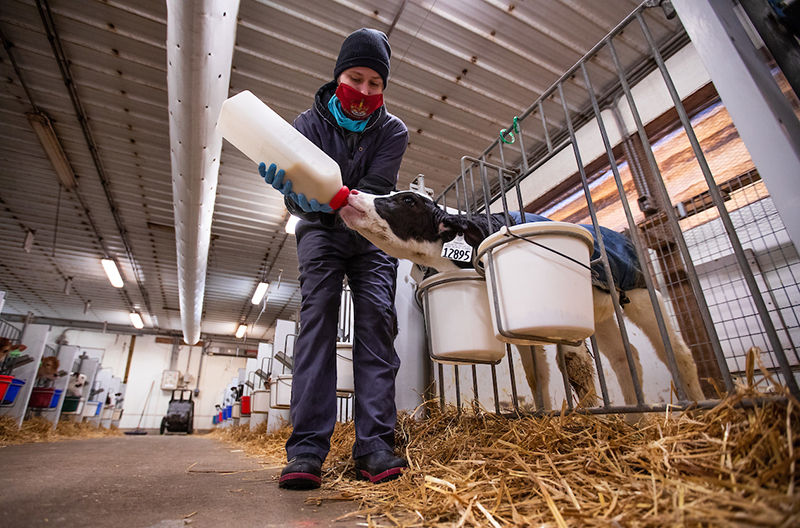
Photos by Christopher Gannon.
Spring means additional (small) animals to care for on the university's teaching farms. Above, animal science junior Sara Chanez, who works at the dairy farm, feeds a month-old female holstein. About 35 calves are born each month at the dairy farm on 260th Street.
Watch them
Dave Olson's farm animals Postcard from Campus
Below, Ben Drescher, director for all the animal science farms, checks on recently hatched chicks at the Robert T. Hamilton Poultry Teaching and Research Facility on State Avenue. The farm broods new chicks every three to four months.
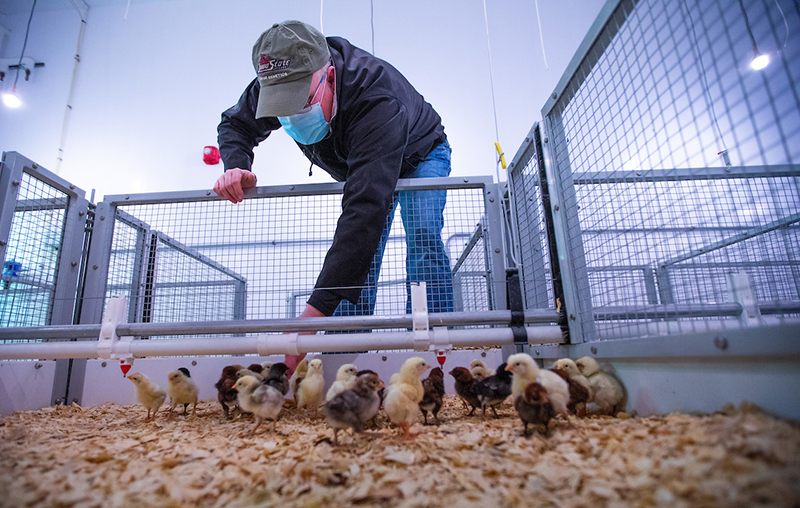
Typical in-person activity expected on campus this fall
Fall 2021 on campus will look far more like 2019 than 2020, if vaccines are as widely available in the coming months as expected.
Resuming similar levels of on-campus activity as before the pandemic has long been a possible goal for this fall, but President Wendy Wintersteen made the intention clear in a March 12 message to students and employees.
"I'm pleased to announce that we are looking forward to a 'new normal' for the upcoming academic year. We are planning to return in-person classes, labs, studios, residence, dining, student activities, and campus events to pre-pandemic levels," Wintersteen said in the message.
The foundation of a full fall return is widespread vaccinations, and campus operations will continue to be based on both appropriate health practices and Iowa State's "deep commitment to academic quality and supporting an excellent student experience," Wintersteen said. It would mark the next step in a progression toward normalcy already underway, including the state Board of Regents rescinding its yearlong systemwide ban on university-sponsored international travel and plans for in-person spring commencement ceremonies.
Existing working groups formed for the university's COVID-19 response will continue their in-depth planning, and a newly formed Moving Forward Coordinating Committee has been established to help coordinate their work and bring high-level issues to senior leaders, Wintersteen said. Vice president for extension and outreach John Lawrence, who chaired the fall planning committee in 2020, also will chair the moving forward committee.
Members of the Moving Forward Coordinating Committee are:
- Vice president for extension and outreach John Lawrence (chair)
- Associate vice president for student health and wellness Erin Baldwin
- Vice president and chief information officer Kristen Constant
- Vice president for university human resources Kristi Darr
- Dean Sam Easterling, College of Engineering
- Associate vice president for campus life Pete Englin
- Associate vice president and dean of students Sharron Evans
- Chemistry chair William Jenks
- Professional and Scientific Council president-elect Chris Johnsen
- Associate vice president for public safety and police chief Michael Newton
- University counsel Michael Norton
- Study abroad center director Frank Peters
- Provost's office communications director Rob Schweers
- Vice president for diversity, equity and inclusion Reg Stewart
- Associate provost for academic programs Ann Marie VanDerZanden
- Associate vice president for institutional financial strategy Bonnie Whalen
- Faculty Senate president-elect Andrea Wheeler
When the pandemic was new
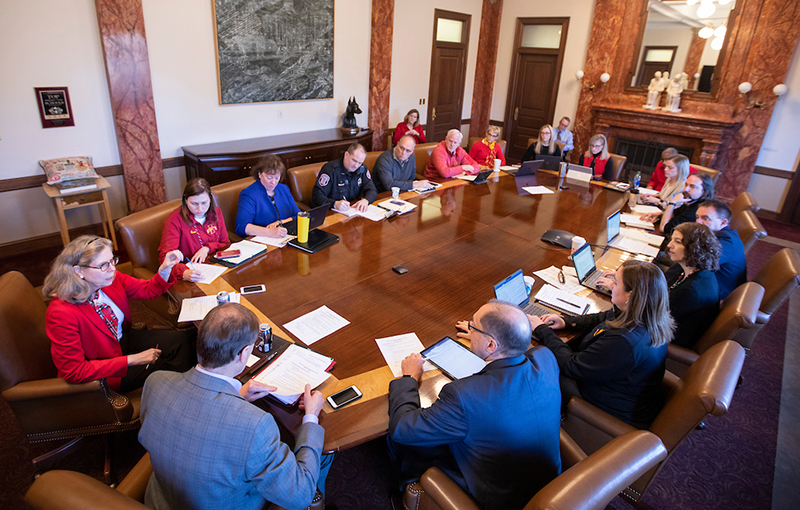
A meeting of campus leaders on March 13, 2020, in the closing days of in-person emergency meetings. Photo by Christopher Gannon.
Last week marked one year since the start of our pandemic year: virtual instruction, remote workplaces, shuttered labs, limited travel and a campus campaign to keep Cyclones apart and healthy. As we headed into spring break week 2020, the state Board of Regents mandated moving courses to online formats after the break and the World Health Organization announced a coronavirus global pandemic. Those came on the heels of several weeks of escalating travel restrictions.
Inside asked several campus leaders to reflect on that turbulent week:
- Erin Baldwin, associate vice president for student health and wellness, director of the Thielen Student Health Center and COVID-19 incident commander
- Kristi Darr, vice president for university human resources
- Pete Englin, associate vice president for campus life and director of the residence department
- Sara Marcketti, Morrill Professor in apparel, events and hospitality management and director of the Center for Excellence in Learning and Teaching
- Jonathan Wickert, senior vice president and provost
Below are excerpts from their responses to four questions.
What are your strongest memories from that week?
Englin: The uncertainty about whether it was realistic we would resume classes (after a proposed initial two weeks in virtual mode), and what does that mean for 9,000 students living with us -- and all their belongings? We kept items into June -- but we didn't know that yet in March. And hearing some early noise around the need to refund millions upon millions of room and board fees because people still would have housing and food expenses. The fair thing is to make that happen, the challenge is: What does that mean for our staff and their families? And finally, the overwhelming vulnerability of our students and staff about what COVID-19 might mean. How do we as a department, as well as a university, make this feel caring and supportive through a crisis of proportions we'd never seen?
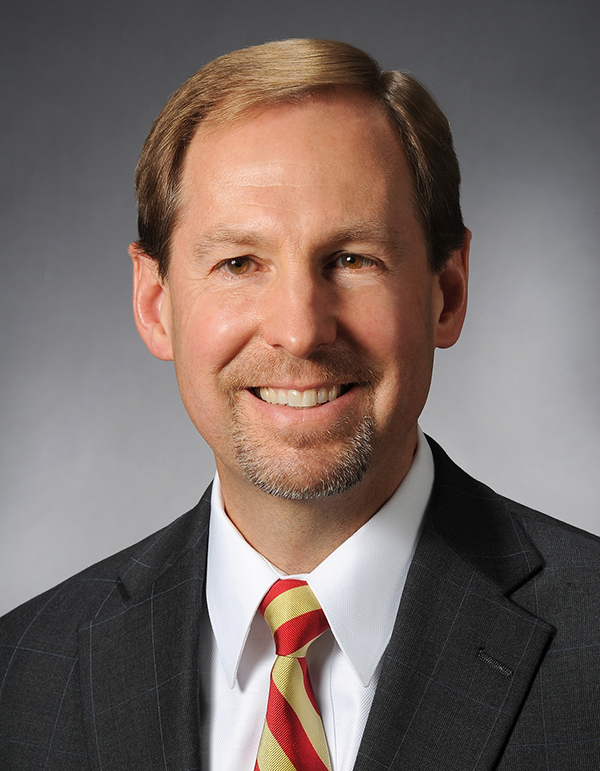
Jonathan Wickert
Wickert: It was a chain of events on Tuesday of that week. A weekly 10 a.m. meeting of my staff included a 'what-if' discussion about what we would do if we had to move classes online very quickly. Then there was a call after lunch involving the three universities and the board office about the possibility of going online. At 3:30, as the Faculty Senate meeting is starting in the Memorial Union Sun Room, I was in the back of the room on the phone with President Wintersteen, who informed me we were going online after spring break. Just as Jonathan Sturm was introducing me, the whole message I needed to share changed. So the very first announcement of the change, appropriately, was to Faculty Senate: We're going to move 7,000 classes online in 10 days, and we're going to have to figure it out.
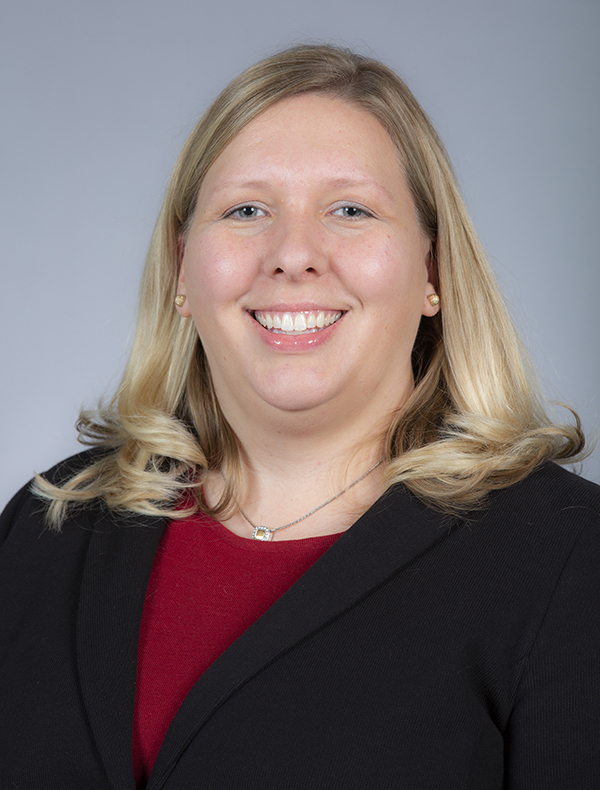
Erin Baldwin
Baldwin: I remember watching the virus spread in country after country and thinking 'This will be a pandemic.' My clearest memory is with all the support and coordination that was happening among study abroad, risk management, the health center and several colleges involved in returning our students from South Korea, China and Italy. There were many, many logistics to work out to support students and their families. Quarantining and testing were brand new ideas back then!
Darr: Feeling the pace pick up, the need to respond and be supportive and to have everyone's subject matter expertise be listened to. I recall a Friday afternoon meeting of campus leaders in the president's conference room (pictured above). We were in the same room, physically, and it was full. And how valuable it was to see expressions on faces, to develop relationships in those early days when we were all leaning in and learning.
What were the priorities guiding your decision-making as things evolved so quickly?
Wickert: From Day One, the two priorities I tried to share consistently were: Ensure the health and safety of students, faculty and staff; and maintain students' progress toward completing their degrees.
Baldwin: Staying connected to the most up-to-date information from the experts -- CDC, World Health Organization, Iowa Department of Public Health and local public health experts -- to make science-based decisions for Iowa State. And then to make sure we were communicating information and resources with campus. And, most importantly, making sure our planning supported our students, faculty and staff.
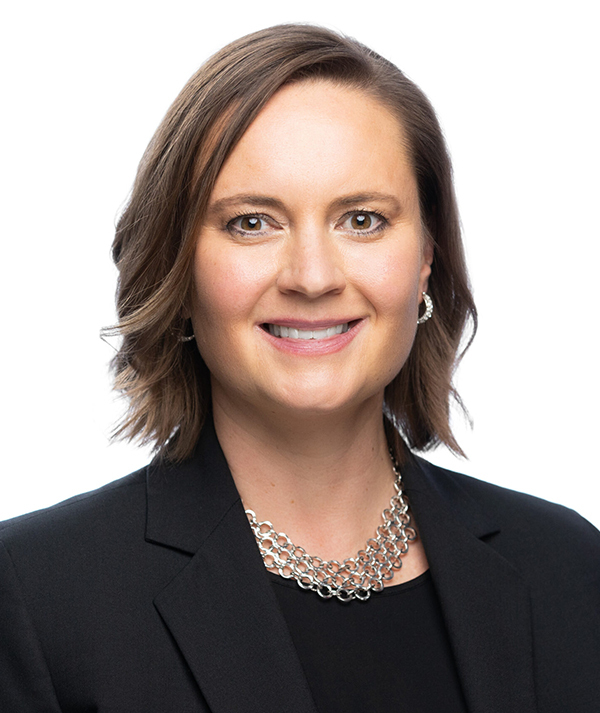
Sara Marcketti
Marcketti: First, to keep calm. The very word 'pandemic' is frightful. As CELT director, a faculty member teaching that semester, a mom, I knew I had to keep a level head even if internally I felt pretty stirred up. Number two, to communicate as clearly as we could through our website, teaching tips and programming information that was as simple as possible. We wanted to make sure we were contributing to the coordinated university response during a very chaotic time.
Englin: First, it was the students and our staff and their well-being. And then came the organizational implications: How to sustain and honor our Iowa State model -- the whole Cyclone experience -- that's been in existence since the university started. But I trusted in our collective resilience that we would find a way forward because that's what our history is. To know that ultimately, we will be OK, even though we don't know what tomorrow will bring.
What was the moment when you realized everything would change?
Baldwin: As early as February, as we were comparing COVID to other illnesses, I think I knew what was coming. I remember presenting to President's Council in February on COVID, and now we know that was just the base of what was coming.
Marcketti: I led an inclusive training workshop for the agronomy department late Friday afternoon (March 13) and was walking back to Morrill Hall. Campus was really quiet, and it hit me that workshop might be the last time I stood that close to people or shook their hands. It was really clear to me that this was it.
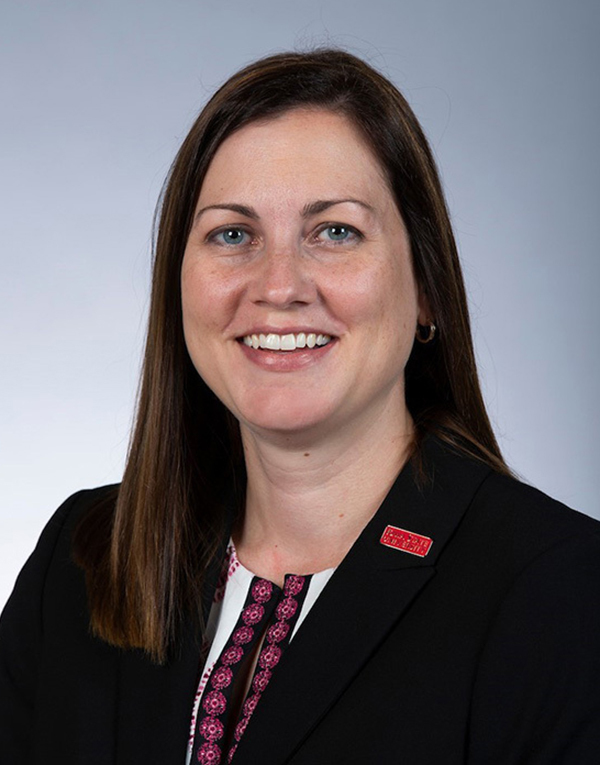
Kristi Darr
Darr: My family made the decision to go ahead with a spring break trip to visit grandparents in Ohio [Workday preempted spring trips the previous few years]. But that weekend (March 14-15), the weight of the worry for all our faculty and staff's safety was enormous. I was realizing I couldn't manage this from Ohio with a cellphone and a bad connection. So, on Sunday we headed back to Iowa. I rode in the passenger seat and had a little mobile command center with two phones and a laptop, talking on the phone, evaluating documents, getting updates from others. I felt so relieved when we got here.
Englin: Things began for the residence department when we were providing isolation and quarantine housing for students returning from study abroad, including Italy. We watched the enormity of what was happening [in Italy] in what felt like minutes. It felt like waiting for a tsunami to come but understanding there was no way to avoid it. I came to the realization this wasn't going to be a two-week dynamic; this was going to be with us for a while. I would never have guessed a year.
A year later, what's your assessment of that week and the university's initial response to really challenging circumstances?
Marcketti: We kept the reason we have a university -- our students -- at the heart of decisions. We talk about silos, but I saw a lot of people with varied areas of expertise bringing their knowledge, their care and support to try to help our students and help each other. There was a calmness, a reasoned response coming from the president's office and the provost's office, and at CELT we just tried to follow that.
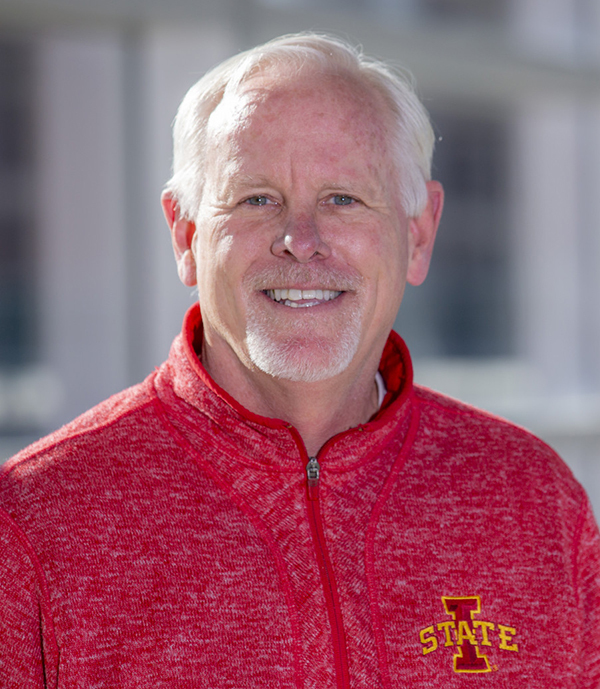
Pete Englin
Englin: Similar to when campus flooded a few times, I was reminded how Iowa State shines when faced with immense challenges. I can't point to another institution and say 'They figured this out better than we ever did.' I don't know one. Iowa State has done an incredible job of threading the needle. And not one decision has been easy because every decision had people who were cheerleaders for what we were doing and others who would engage in a deep critique and raise objections. There weren't any clear-cut decisions.
Wickert: My main reaction is one of pride in everyone at the university. I'm talking about our police force, residence staff, communications team, faculty, an 18-year-old freshman adapting to so many things. We were dealing with a new, frankly scary, thing, and our reaction was, we're going to roll up our sleeves, we're going to break it down and we're going to work the problem.
Darr: Just really great teamwork. There weren't a lot of lanes early on; it was just share information, hear information and adjust. You could just watch, first one unit kind of be in the fire, then the next unit was in the fire as we rolled to the next big decision -- study abroad students, employee safety, online instruction. Folks just leaned in, raised their hand and said 'Hey, did you think of this?'
Baldwin: Our really large campus came together to make some massively complex changes happen in a matter of days. Specifically, in my role of incident commander and as leader of the public health team, I'm so incredibly proud of how we stood up a public health infrastructure from the ground up, particularly because we don't have a health care system or medical or public health school to support our work. So many colleagues from across campus stepped up to make it happen.
Campus visits scheduled for library dean finalists
Five finalists have been identified in the search for the next dean of library services. Their campus visits are scheduled over the next three weeks:
- Candidate 1, March 25-26
- Candidate 2, March 29-30
- Candidate 3, April 1-2
- Candidate 4, April 5-6
- Candidate 5, April 8-9
Candidates will be announced one business day before their visits, which will include meetings with faculty and staff. Check the provost's office search page for details, including finalists' curriculum vitae and interview itineraries.
The candidates also will participate in a virtual open forum (3-4 p.m. via Webex) on the first day of their visits. The forums will be recorded for those unable to attend and made available after all campus visits have concluded. Forum dates are:
- Candidate 1, Thursday, March 25
- Candidate 2, Monday, March 29
- Candidate 3, Thursday, April 1
- Candidate 4, Monday, April 5
- Candidate 5, Thursday, April 8
Related stories
- Search for library dean begins, Oct. 15, 2020
- Seo appointed interim dean of University Library, May 2, 2019
Instructors find ways to virtually engage, care for students
Assistant professor of theater Cason Murphy couldn't have planned it better, even if he saw this coming. Murphy is one of many instructors across campus this spring whose online teaching creativity helps hold students' attention and challenge them during a pandemic.
Murphy is redefining how students interact with a webcam, while art and visual culture associate professor April Eisman brings more accountability to asynchronous classes by adding a personal touch. School of Education assistant professor T.J. Stewart spends time on the person before the content to make class successful.
Ready for a close-up
Murphy is teaching Acting for the Camera for the first time and is surprised by the opportunities hybrid instruction presents. Not intentional when the course was approved last year, the webcam has added a different dimension.
"We have been doing a lot of exercises with Zoom, and having students there in relationship with the camera has been more beneficial than if we were in a traditional classroom," he said. "We have been able to do a lot more work immediately due to the fact that we are online."
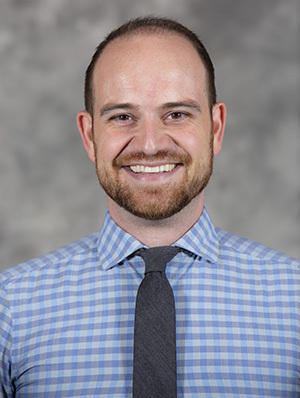
Cason Murphy
Murphy focuses on making each Zoom session lively with numerous activities. Instead of sending students to different corners of a room, he divides them up into breakout rooms to work scenes before returning to perform for their classmates.
"I try to get them to reimagine their relationship with the webcam, so they realize it doesn't just have to be them sitting there," Murphy said. "What happens if we zoom out or really far in, and what if we take a little bit of control over this experience?"
Students also film a scene from a movie, upload it to CyBox and have it critiqued in class.
"It has been a way to make it feel so much less rote in how we interact with virtual instruction," Murphy said.
He also uses Zoom's chat function to keep communication going and even direct instruction.
"The chat function takes away a little bit of that vulnerability and allows students to throw things in there," Murphy said. "They will provide links that relate to the topic, and we just go with it."
Accountability
Eisman uses several methods to engage her Design students and keep them accountable while teaching asynchronously. She sends out weekly messages to highlight the material and alert students to assignments and due dates. Every few weeks she offers an optional assignment to learn what students like and found beneficial about the last week of class, using it as a chance to check in with them.
"I will ask them about things like COVID and if they feel safe," Eisman said. "I also ask them if they want to hear back from me. They can say 'yes' or just let me know they are sharing what they think. It lets me know who wants or needs that social contact."
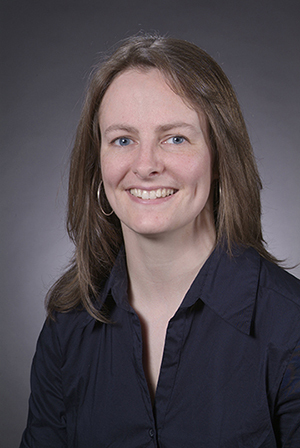
April Eisman
To keep students accountable, Eisman embeds questions within videos she makes (or shares) that account for 25% of their grade. The questions are not difficult, but require students pay attention to be successful. Eisman also has weekly readings and quizzes that are another 25% of students' grades.
To promote an interactive and social reading experience, Eisman is using Perusall for the first time. Available in Canvas, Perusall allows students to highlight information in the text to comment on or talk to one another about.
"At the undergraduate level, I think it really creates an excitement among the students," Eisman said. "Students can like comments or ask questions, and it helps me find out what they are thinking about and questions and misunderstandings they are having."
Questions may not be answered in real time, but it allows students to get feedback from their peers and take some responsibility for their learning. Perusall also assists instructors by tracking how long students are actively reading as opposed to just having the book open.
This spring, Eisman changed the deadline for all assignments from midnight to 10 p.m. after her department talked with student counseling services.
"There are students who are going to wait until the last minute, but there are plenty of 20-year- olds who want to go to bed by 10 p.m.," she said. "I put it on my syllabus and explained I want them to get sleep because it is important."
Caring for the individual
Stewart is teaching a graduate course in advising and helping skills, which prepares students to work in student affairs positions at colleges and universities.
He uses several techniques to push virtual platform boundaries with activities such as speed dialoging and apps in Canvas like Flipgrid.
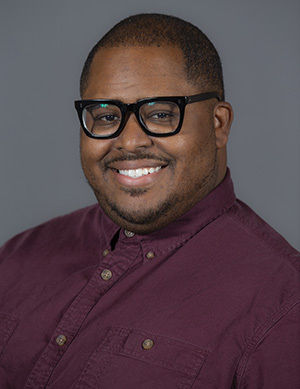
T.J. Stewart
"We start in the large room of Zoom, I pop up a question and then put them in breakout rooms for the length of a song," he said. "When that song is over, I close the room and we go to a new question."
Flipgrid allows students to send videos back and forth to ask and answer questions to break up the monotony of the virtual environment.
Stewart puts students' emotional well-being at the forefront by adapting activities he does in-person into online classes. He uses chat as a way for students to build relationships with one another.
"I post a statement on the screen that will say, 'Someone I have learned from this semester,' and then students send a private chat to someone that fits that statement for them," he said.
Showing appreciation for others in the virtual format has been successful for Stewart and reflected in near perfect student attendance this semester.
"I don't think you can learn from an empty cup, so until we can find ways to deal with the socioemotional, students are not as energized or primed to get through the content," Stewart said. "It can't only be about the content."
Many of the students also are teaching or in assistantships as part of their graduate program, and Stewart feels it is important to model kind, caring behavior they can apply in their work.
Nonverbal cues
Murphy also teaches a large lecture class, Introduction to the Performing Arts. Identifying nonverbal cues that indicate students are engaged can be difficult in virutal instruction. In addition to the chat function, Murphy uses polls to accomplish it.
"I do a build-your-own-adventure," he said.
Students vote to determine things like the protagonist, the villain and the inciting incident. Improv takes over from there as they build scenes and dialogue.
Stewart uses a variety of ways to gauge students' mindsets at different points during class, ranging from one-word check-ins to selecting a song that speaks to how they are feeling.
"Hearing all those words at the top of a class helps me know how we need to proceed, or if I need to jump in and do some care work," he said.
Move online is a boon for Open Scholar Café
The pandemic disrupted events across campus over the past year, but moving online proved fruitful for Parks Library in at least one instance. In recent years, October's open access week included the Open Science Coffee Confab. It brought together campus experts to discuss different open scholarship topics but did not have a significant number of attendees.
Open Scholar Café upcoming dates
- Thursday, April 15
- Wednesday, May 19
- Thursday, June 17
- Wednesday, July 21
* All meetings are 9-10 a.m.
"People didn't have time to come out to the library or there were things holding people back from trying it," open access and scholarly communication librarian Abbey Elder said.
The pandemic gave Parks staff the opportunity to try the event virtually, and it was a hit. Elder said attendance was three times greater than past meetings. That success -- coupled with faculty asking for similar events -- led to the Open Scholar Café. It is a monthly virtual forum for members of the ISU community to meet and discuss open research and scholarship with their peers organized by the library's open scholarship services.
"It is a place where faculty drop in and talk about what other people are working on that they are interested in, or things they are working on or want to in the future," Elder said.
The goal is to build community with faculty and graduate students on campus who might benefit by partnering with the library or are looking for collaborators for their research and projects, Elder said.
The Open Scholar Café has a code of conduct that emphasizes being welcoming, supportive and comfortable and where harassment is not tolerated. Elder said that doesn't mean difficult topics won't be addressed in meetings, but it sets a positive framework to guide discussion.
Meeting
The virtual meetings began in February with associate university librarian for scholarly communication and collections Curtis Brundy outlining how the library supports open access through its publisher agreements. March's meeting focused on how instructors have incorporated open educational resources into their teaching, and April will center on research data services for faculty.
The café meets once a month, alternating every third Wednesday and Thursday to allow people to attend from 9-10 a.m. Dates are set through July, but Elder hopes to increase forums to twice a month in the future. Registration is preferred but not required.
Expanding topics
Topics currently center around the expertise of library staff, but there is a suggestion link on the website for individuals who want to lead or propose an idea.
"We have already had a few suggestions that we are trying to figure out who will come in and speak about them," Elder said.
There also is interest in branching out discussion topics.
"There are different topics of interest to the faculty, so there is always a chance it is something we don't specialize in," Elder said. "In those situations, we are happy to partner with groups outside of the library like [the Center for Excellence in Learning and Teaching] for instructional design or [the vice president for research] office for grant support."
Writing and Media Center plans author series
The Writing and Media Center is holding a series of virtual forums this spring that offer aspiring writers a chance to connect with a variety of published authors.
It's the first author series hosted by the center, though the plan is to continue them in coming semesters, said director Joseph Cheatle. It's another way the center can serve students while also engaging faculty, staff and the community, a growing focus for the center.
"We see these events as important opportunities to expand the conversation of writing on campus through unique and innovative speakers," Cheatle said. "They introduce the Writing and Media Center to key stakeholders while also providing valuable learning and interactive experiences."
The series also helps highlight the work of Iowa State writers across various disciplines. ISU faculty and staff are represented in each of the sessions, which cover poetry, novels and nonfiction.
Register online for the events. Here's the schedule and details:
- Nonfiction publishing panel, March 22 (4-5:30 p.m.) The panel includes Reiman Gardens director Ed Lyon (author of "Growing the Midwest Garden"), Maryland-based freelance writer Dara T. Mathis and Katharine A. Burnett, associate professor of English at Fisk University in Nashville, Tennessee. Panelists will discuss writing book proposals, negotiating contracts and securing freelance assignments.
- "Allison Boyd Justus: An Afternoon of Poetry," April 9 (2-3 p.m.) Justus is a student in Iowa State's master of fine arts program in creative writing and environment, a graduate communication consultant at the Writing and Media Center, and the author of "Solstice to Solstice to Solstice: A Year of Sunrises in Poetry."
- "'Hey! That's My Book': Taking Your Writing from Distant Dream to Shelves," April 22 (7-8:30 p.m.) Assistant director of multicultural student affairs Denise Williams ("How to Fail at Flirting") and associate teaching professor in English Rachel Mans McKenny ("The Butterfly Effect") have both published novels. They'll take questions about fiction writing, finding time to write with a full-time job and family, and balancing creativity and business.
